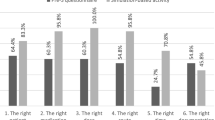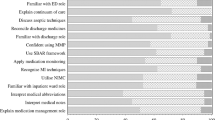Abstract
Proportional reasoning is the basis for most medication calculation processes and is fundamental for high-quality care and patient safety. We designed a simulated Medication Mathematics (siMMath) environment to support proportional reasoning in transitioning via concreteness fading between two mediators. The first mediator is simulated nursing tools of medication preparation. The second is a ratio-table setup which is used as a goal representation, which enables one to spatially hold in place different quantities in their relative proportion. We conducted a two-part study with nursing students. Part 1 was a quasi-experimental pretest–intervention–posttest design assessing the effectiveness of learning, by evaluating four categories of medical calculation questionnaire items (solid medications, unit conversion, concentrations, infusion rates). We used the Noelting proportional reasoning test to evaluate the generalizability and abstraction of proportional reasoning. Part 1 included an experimental group (n = 96) learning with siMMath, and a comparison group (n = 73) learning with an equation-based lecture approach. Part 2 employed a case study design to characterize the learning process. The experimental group’s learning gains were significantly higher than the comparison group’s for the two most challenging categories of the medication calculation problems questionnaire, namely concentrations and infusion rates. Furthermore, the experimental group’s learning gains were significantly higher than the comparison group’s for formal operational reasoning on the Noelting test. Students who used a ratio-table setup scored significantly higher on the Noelting posttest questionnaire. Nursing students who learned with the siMMath environment overcame difficulties in proportional reasoning to the highest levels and extended this understanding to other contexts.



Similar content being viewed by others
References
Abrahamson, D. (2013). Toward a taxonomy of design genres: Fostering mathematical insight via perception-based and action-based experiences. In J. P. Hourcade, E. A. Miller, & A. Egeland (Eds.), Proceedings of the 12th International Conference on Interaction Design and Children (IDC 2013) (pp. 218–227). New York, NY: Association for Computing Machinery.
Anderson, J. R., Reder, L. M., & Simon, H. A. (1996). Situated learning and education. Educational Researcher, 25(4), 5–11.
Aspden, P., Wolcott, J., Bootman, J. L., & Cronenwett, L. R. (2007). Preventing medication errors: Quality chasm series. Washington, DC: National Academies Press.
Bagnasco, A., Galaverna, L., Aleo, G., Grugnetti, A. M., Rosa, F., & Sasso, L. (2016). Mathematical calculation skills required for drug administration in undergraduate nursing students to ensure patient safety. A descriptive study: Drug calculation skills in nursing students. Nurse Education in Practice, 16(1), 33–39.
Bart, W. M., & Williams-Morris, R. (1990). A refined item digraph analysis of a proportional reasoning test. Applied Measurement in Education, 3(2), 143–165.
Basak, T., Aslan, O., Unver, V., & Yildiz, D. (2016). Effectiveness of the training material in drug-dose calculation skills. Japan Journal of Nursing Science, 13, 324–330.
Bates, D. W. (2007). Preventing medication errors: A summary. American Journal of Health, 64(14), S3–S9.
Bindler, R., & Bayne, T. (1991). Medication calculation ability of registered nurses. Journal of Nursing Scholarship, 23(4), 221–224.
Brown, J., Collins, A., & Duguid, P. (1989). Situated cognition and the culture of learning. Educational Researcher, 18(1), 32–42.
Bruner, J. S. (1966). Toward a theory of instruction. Cambridge, MA: Harvard University Press.
Carraher, T. N. (1986). From drawings to buildings: Working with mathematical scales. International Journal of Behavioral Development, 9(4), 527–544.
Carraher, T. N., Carraher, D. W., & Schliemann, A. D. (1985). Mathematics in the streets and in schools. British Journal of Developmental Psychology, 3(1), 21–29.
Coben, D., & Weeks, K. (2014). Meeting the mathematical demands of the safety-critical workplace: Medication dosage calculation problem-solving for nursing. Educational Studies in Mathematics, 86(2), 253–270.
Courtney-Clarke, M. & Wessels, H. (2014). Number sense of final year pre-service primary school teachers. Pythagoras, 35(1), Article 244, 1–9.
Deichert, D. L. (2014). The conceptual field of proportional reasoning researched through the lived experiences of nurses (Doctoral dissertation). Retrieved from Stars Electronic Theses and Dissertations. (UMI No. 660).
Draney, K., & Wilson, M. (2007). Application of the Saltus model to stagelike data: Some applications and current developments. In M. von Davier & C. H. Carstensen (Eds.), Multivariate and mixture distribution Rasch models (pp. 119–130). New York, NY: Springer.
Ercole, L. K., Frantz, M., & Ashline, G. (2011). Multiple ways to solve proportions. Mathematics Teaching in the Middle School, 16(8), 482–490.
Fritz, C. O., Morris, P. E., & Richler, J. J. (2012). Effect size estimates: Current use, calculations, and interpretation. Journal of Experimental Psychology: General, 141(1), 2–18.
Fyfe, E. R., McNeil, N. M., & Borjas, S. (2015). Benefits of “concreteness fading” for children’s mathematics understanding. Learning and Instruction, 35, 104–120.
Fyfe, E. R., McNeil, N. M., Son, J. Y., & Goldstone, R. L. (2014). Concreteness fading in mathematics and science instruction: A systematic review. Educational Psychology Review, 26(1), 9–25.
Glaister, K. (2007). The presence of mathematical and computer anxiety in nursing students and their effects on medication dosage calculations. Nurse Education Today, 27, 341–347.
Grandell-Niemi, N., Hupli, M., & Leino-Kilpi, M. (2005). Finnish nurses’ and nursing students’ pharmacological skills. Journal of Clinical Nursing, 6, 685–694.
Gravemeijer, K., & van Galen, F. (2003). Making mathematics reasonable in school: A research companion for the principles and standards for school mathematics. Reston, VA: National Council of Teachers of Mathematics.
Greenfield, S., Whelan, B., & Cohn, E. (2006). Use of dimensional analysis to reduce medication errors. Journal of Nursing Education, 45(2), 91–94.
Harries, C., & Botha, J. (2013). Assessing medical students’ competence in calculating drug doses. Pythagoras, 34(2), 1–9.
Harris, M. A., Pittiglio, L., Newton, S. E., & Moore, G. (2014). Using simulation to improve the medication administration skills of undergraduate nursing students. Nursing Education Perspectives, 35(1), 26–29.
Howe, C., Nunes, T., & Bryant, P. (2010). Intensive quantities: Why they matter to developmental research. British Journal of Developmental Psychology, 28(2), 307–329.
Howe, C., Nunes, T., & Bryant, P. (2011). Rational number and proportional reasoning: Using intensive quantities to promote achievement in mathematics and science. International Journal of Science and Mathematics Education, 9(2), 391–417.
Hoyles, C., Noss, R., Kent, P., & Bakker, A. (2010). Improving mathematics at work: The need for techno-mathematical literacies. New York, NY: Routledge.
Hoyles, C., Noss, R., Kent, P., & Bakker, A. (2013). Mathematics in the workplace: Issues and challenges. In A. Damlamian, J. F. Rodrigues, & R. Sträßer (Eds.), Educational interfaces between mathematics and industry (Vol. 16, pp. 43–50). Cham, Switzerland: Springer.
Hoyles, C., Noss, R., & Pozzi, S. (2001). Proportional reasoning in nursing practice. Journal for Research in Mathematics Education, 32, 4–27.
Hughes, R. G. (Ed.). (2008). Patient safety and quality: An evidence-based handbook for nurses. Rockville, MD: Agency for Healthcare Research and Quality.
Inhelder, B., & Piaget, J. (1958). The growth of logical thinking from childhood to adolescence: An essay on the construction of formal operational structures. New York, NY: Basic Books.
Kaminski, J. A., Sloutsky, V. M., & Heckler, A. F. (2008). The advantage of abstract examples in learning math. Science, 320, 454–455.
Kapborg, I. D. (1995). An evaluation of Swedish nurse students’ calculating ability in relation to their earlier educational background. Nurse Education Today, 15(1), 69–74.
Kaput, J. J., & West, M. (1994). Missing-value proportional reasoning problems: Factors affecting informal reasoning patterns. In G. Harel & J. Confrey (Eds.), The development of multiplicative reasoning in the learning of mathematics (pp. 235–287). Albany, NY: State University of New York Press.
Kirshner, D., & Awtry, T. (2004). Visual salience of algebraic transformations. Journal for Research in Mathematics Education, 35(4), 224–257.
Lamon, S. J. (2007). Rational numbers and proportional reasoning: Toward a theoretical framework for research. In F. K. Lester (Ed.), Second handbook of research on mathematics and learning: A project of the National Council of Teachers of Mathematics (pp. 629–666). Charlotte, NC: Information Age.
Landy, D., & Goldstone, R. L. (2007). How abstract is symbolic thought? Journal of Experimental Psychology: Learning, Memory, and Cognition, 33(4), 720–733.
Landy, D., & Goldstone, R. L. (2010). Proximity and precedence in arithmetic. The Quarterly Journal of Experimental Psychology, 63(10), 1953–1968.
Lave, J. (1977). Cognitive consequences of traditional apprenticeship training in West Africa. Anthropology & Education Quarterly, 8(3), 177–180.
Lave, J. (1988). Cognition in practice: Mind, mathematics and culture in everyday life. Cambridge, UK: Cambridge University Press.
Lave, J., & Wenger, E. (1991). Situated learning: Legitimate peripheral participation. Cambridge, UK: Cambridge University Press.
Macdonald, K., Weeks, K. W., & Moseley, L. (2013). Safety in numbers 6: Tracking pre-registration nursing students’ cognitive and functional competence development in medication dosage calculation problem-solving: The role of authentic learning and diagnostic assessment environments. Nurse Education in Practice, 13(2), e66–e77.
McMullan, M., Jones, R., & Lea, S. (2012). Math anxiety, self-efficacy, and ability in British undergraduate nursing students. Research in Nursing & Health, 35(2), 178–186.
Middleton, J. A., & van den Heuvel-Panhuizen, M. (1995). The ratio table. Mathematics Teaching in the Middle School, 1(4), 282–288.
Noelting, G. (1980a). The development of proportional reasoning and the ratio concept: Part I—differentiation of stages. Educational Studies in Mathematics, 11(2), 217–253.
Noelting, G. (1980b). The development of proportional reasoning and the ratio concept: Part II—problem-structure at successive stages; problem-solving strategies and the mechanism of adaptive restructuring. Educational Studies in Mathematics, 11(3), 331–363.
Noss, R., & Hoyles, C. (1996). Windows on mathematical meanings: Learning cultures and computers.Dordrecht, The Netherlands: Kluwer Academic.
Noss, R., Hoyles, C., & Pozzi, S. (2002). Abstraction in expertise: A study of nurses’ conceptions of concentration. Journal for Research in Mathematics Education, 33, 204–229.
Perlstein, P. H., Callison, C., White, M., Barnes, B., & Edwards, N. K. (1979). Errors in drug computations during newborn intensive care. American Journal of Diseases of Children, 133(4), 376–379.
Piaget, J. (1950). The psychology of intelligence. London, UK: Lowe & Brydone.
Price-Williams, D., Gordon, W., & Ramirez, M. (1969). Skill and conservation: A study of pottery-making children. Developmental Psychology, 1(6, Pt. 1), 769.
Reed, H. J., & Lave, J. (1981). Arithmetic as a tool for investigating between culture and cognition. In R. Casson (Ed.), Language, culture and cognition: Anthropological perspectives (pp. 437–455). New York, NY: Macmillan.
Rice, J. N., & Bell, M. L. (2005). Using dimensional analysis to improve drug dosage calculation ability. Journal of Nursing Education, 44(7), 315–318.
Saxe, G. B. (1988). Candy selling and math learning. Educational Researcher, 17(6), 14–21.
Schwartz, J. L. (1988). Intensive quantity and referent transforming arithmetic operations. In J. Hiebert & M. Behr (Eds.), Number concepts and operations in the middle grades (Vol. 2, pp. 41–52). Hillsdale, NJ: Lawrence Erlbaum Associates.
Sowder, J., Armstrong, B., Lamon, S., Simon, M., Sowder, L., & Thompson, A. (1998). Educating teachers to teach multiplicative structures in the middle grades. Journal of Mathematics Teacher Education, 1(2), 127–155.
Van Lancker, A., Baldewijns, K., Verhaeghe, R., Robays, H., Buyle, F., Colman, R., & Van Hecke, A. (2016). The effectiveness of an e-learning course on medication calculation in nursing students: A clustered quasi-experimental study. Journal of Advanced Nursing, 9, 2054–2064.
Vergnaud, G. (1982). Cognitive and developmental psychology and research in mathematics education: Some theoretical and methodological issues. For the Learning of Mathematics, 3(2), 31–41.
Wright, K. (2004). An investigation to find strategies to improve student nurses’ math skill. British Journal of Nursing, 13, 1280–1284.
Wright, K. (2007). Student nurses need more than math to improve their drug calculating skills. Nurse Education Today, 27, 278–285.
Wright, K. (2008). Can effective teaching and learning strategies help student nurses to retain drug calculation skills? Nurse Education Today, 7, 856–864.
Wright, K. (2009). The assessment and development of drug calculation skills in nurse education—a critical debate. Nurse Education Today, 5, 544–548.
Acknowledgements
We appreciate and thank Ms. Dalit Wilhelm, the head of the clinical unit at the Cheryl Spencer Department of Nursing, University of Haifa, for her major contributions to planning and enacting the research, as well as a source of support. We are especially grateful to the nursing students who voluntarily participated in our research and whose insights helped to improve siMMath environment.
This research was supported in part by the Cheryl Spencer Institute of Nursing Research, University of Haifa, and by the MEITAL Foundation, which assists Israeli institutions of higher education in advancing the use of e-learning technologies.
Author information
Authors and Affiliations
Corresponding author
Rights and permissions
About this article
Cite this article
Dubovi, I., Levy, S.T. & Dagan, E. Situated Simulation-Based Learning Environment to Improve Proportional Reasoning in Nursing Students. Int J of Sci and Math Educ 16, 1521–1539 (2018). https://doi.org/10.1007/s10763-017-9842-2
Received:
Accepted:
Published:
Issue Date:
DOI: https://doi.org/10.1007/s10763-017-9842-2




